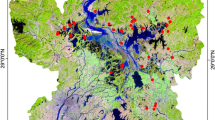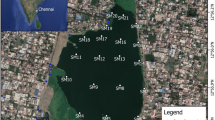Abstract
Establishing factors that affect contaminants including potentially toxic metals in a freshwater and its surrounding soil is necessary to control the transfer of toxins into the food chain. We documented the seasonality in temperature, dissolved oxygen (DO), soil organic carbon (SOC), pH, and water color on the behavior of toxic metals in water and soil of Lake Nike. Slope and seasons statistically related significantly (p < 0.05) with DO and SOC. Only Ni was not statistically related significantly to pH, water color, and temperature of the water, while mercury and cadmium statistically related significantly to the soil pH. Temperature and pH were within the WHO safety limits which are 20–32 °C and 6.5–8.5, respectively, in both water and soil samples. Potentially toxic metals levels for lead (Pb) (0.47–2.10 mg/L), mercury (Hg) (0.57–2.01 mg/L), cadmium (Cd) (0.34–1.82 mg/L), and nickel (Ni) (0.56–2.09 mg/L) exceeded the 0.01, 0.001, 0.003, and 0.02 mg/L WHO safety limits, respectively, while Zinc (Zn) level which ranged from 0.24 to 2.51 mg/L was within the WHO limit (5 mg/L) and the standard organization of Nigeria (SON) limit (3.0 mg/L) in both seasons. From our study, Lake Nike could be relatively toxic, and unsafe for aquatic habitation and human consumption.




Similar content being viewed by others
Data availability statement
All data will be available from the corresponding author upon reasonable request.
Code availability
Non applicable.
References
Ahmad W, Alharthy RD, Zubair M, Ahmed M, Hameed A, Rafique S (2021) Toxic and heavy metals contamination assessment in soil and water to evaluate human health risk. Sci Rep 11:1–12. https://doi.org/10.1038/s41598-021-94616-4
Akubue PI (2013) Poisons in our environment and drug overdose: a guide for health professionals and the lay public. 2nd Eds. 123
Al Farajat M, Al Ansari N, Mashagbeh A, Abou-Salah R (2005) Hydrogeophysical and environmental investigations of groundwater potentials in Al Sokhna alluvium aquifer in Zarqa—Jordan. Hydrogeologie Und Umwelt 7:1–15
Amalu TE, Ajake AO (2018) Developing natural lakes for socio-economic development: the case of Nike lake Enugu state, Nigeria. Geo J 2018:1–13. https://doi.org/10.1007/s10708-018-9873-4
Andong FA, Ezenwaji NE, Melefa TD, Hinmikaiye FF, Nnadi OV, Oluwafemi O (2019) Assessment of the physical and chemical properties of Lake Oguta (Nigeria) in relation to the water quality standard established by the Nigerian Federal Ministry of Water Resources. Adv Oceanogr Limnol 10:74–78. https://doi.org/10.4081/aiol.2019.8522
Baysal A, Ozbek N, Akman S (2013) Determination of trace metals in waste water and their removal processes. INTECH 7:145–165. https://doi.org/10.5772/52025
Braga F, Scarpa GM, Brando VE, Manfè G, Zaggia L (2020) COVID-19 lockdown measures reveal human impact on water transparency in the Venice Lagoon. Sci Total Environ 736:1–6. https://doi.org/10.1016/j.scitotenv.2020.139612
Carroll EM, Miller WW, Johnson DW, Saito L, Qualls RG, Walker RF (2007) Spatial analysis of a large magnitude erosion event following a Sierran wildfire. J Environ Qual 36(4):1105–1111
D’Alpaos A, Carniello L, Rinaldo A (2013) Statistical mechanics of wind wave-induced erosion in shallow tidal basins: inferences from the Venice Lagoon. Geophys Res Lett 40(13):3402–3407. https://doi.org/10.1002/grl.50666
Defendi V, Kovačević V, Arena F, Zaggia L (2010) Estimating sediment transport from acoustic measurements in the Venice Lagoon inlets. Cont Shelf Res 30(8):883–893.
Dirican S (2015) Assessment of water quality using physicochemical parameters of Çamlıgöze Dam Lake in Sivas, Turkey. Ecologia 5:1–7. https://doi.org/10.3923/ecologia.2015.1.7
Egborde ABM (1979) The seasonal distribution of phytoplankton of the Lake Asejire—a new impoundment in Nigeria. Proc Int Conf of Kainji Lake River Basins Dev Afr 1:189–202
Elarina ND, Paul SD, Jasha MHA (2014) Trace elements in drinking waters of Meghalaya by using graphite furnace–atomic absorption spectroscopy and in relation to environmental and health issues. J Chem 4(3):348–355
Fissore C, Dalzell BJ, Berhe AA, Voegtle M, Evans M, Wu A (2017) Influence of topography on soil organic carbon dynamics in a Southern California grassland. CATENA 149:140–149
Fritioff A, Kautsky L, Greger M (2005) Influence of temperature and salinity on heavy metal uptake by submersed plants. Environ Pollut 133:265–274
Galipaud M, Gillingham MAF, David M, Dechaume-Moncharmont F-X (2014) Ecologists overestimate the importance of predictor variables in model averaging: a plea for cautious interpretations. Methods Ecol Evol 10:983–991. https://doi.org/10.1111/2041-210X.12251
Gall JE, Boyd RS, Rajakaruna N (2015) Transfer of heavy metals through terrestrial food webs: a review. Environ Monit Assess 187:201–210
Ghose KC, Manna B (2005) Practical Zoology. 2nd Eds. New Central Book Agency Pvt. Ltd., Kolkata
Ghosh GC, Khan MJH, Chakraborty TK, Zaman S, Enamul-Kabir AHM, Tanaka H (2020) Human health risk assessment of elevated and variable iron and manganese intake with arsenic-safe groundwater in Jashore, Bangladesh. Sci Rep 10:1–9. https://doi.org/10.1038/s41598-020-62187-5
Harvey R, Lye L, Khan A, Paterson R (2011) The influence of air temperature and the concentration of dissolved oxygen in Newfoundland rivers. Can Wat Res J 6:171–192. https://doi.org/10.4296/cwrj3602849
Jung MC (2008) Heavy Metal Concentrations in soils and factors affecting metal uptake by plants in the vicinity of a Korean Cu–W mine. Sensors 8:2413–2423
Kacholi DS, Sahu M (2018) Levels and health risk assessment of heavy metals in soil, water, and vegetables of Dares Salaam, Tanzania. J Chem 2018:1–9. https://doi.org/10.1155/2018/1402674
Kaizer AN, Osakwe SA (2010) Physicochemical characteristics and heavy metal levels in water samples from five river systems in Delta State, Nigeria. J Appl Sci Environ 10:1–9
Kassim SM (2012) The importance of recycling in solid waste management. Macromol Sympos 320:43–50. https://doi.org/10.1002/masy.201251005
Kinuthia GK, Ngure V, Beti D, Lugalia R, Wangila A, Kamau L (2020) Levels of heavy metals in wastewater and soil samples from open drainage channels in Nairobi, Kenya:community health implication. Sci Rep 2020:1–9. https://doi.org/10.1038/s41598-020-65359-5
Kritzberg ES, Ekstrom SM (2012) Increasing iron concentrations in surface waters—a factor behind brownification? Biogeosci 9:1465–1478
Lalonde K, Mucci A, Ouellet A, Gelinas Y (2012) Preservation of organic matter in sediments promoted by iron. Nature 483:198–200
Langdon C (2010) Determination of dissolved oxygen in seawater by Winkler titration using the amperometric technique. Int Ocean Carbon Coord Project 134:1–17
Lee J-W, Choi H, Hwang U-K, Kang J-C, Kang YJ, Kim K, Kim J-H (2019) Toxic effects of lead exposure on bioaccumulation, oxidative stress, neurotoxicity, and immune responses in fish: a review. Environ Toxicol Pharmacol 68:101–108
McDowell WH, Wood T (1984) Podsolization–soil processes control dissolved organic carbon concentrations in stream water. Soil Sci 137(1):23–32. https://doi.org/10.1097/00010694-198401000-00004
McLaughlin MJ, Hamon RE, McLaren RG, Speir TW, Rogers SL (2000) A bioavailability-based rationale for controlling metal and metalloid contamination of agricultural land in Australia and New Zealand: a review. Aust J Soil Res 38(6):1037–1086
Nalatambi S (2008) Determination of metals in tap water using atomic absorption spectrometry: a case study in Bandar Sunway residential area. Sunway Acad J 6:33–46
Nazir R, Khan M, Masab M, Rehman HU, Rauf NU, Shahab S, Ameer N, Sajed M, Ullah M, Rafeeq M, Shaheen Z (2015) Accumulation of heavy metals (Ni, Cu, Cd, Cr, Pb, Zn, Fe) in the soil, water and water collected from Tanda Dam Kohat. J Pharm Sci Res 7(3):89–97
Nweze NO (2003) Phytoplankton production in Ogelupe Lake Opi, Enugu state. Nig J Biol Res Biotechnol 1(1):83–96
Nweze NO, Domrufus N (2006) Limnological studies on Nike lake Enugu, Enugu State—the metaphyton and some physic—chemical aspects. Nig J Bot 19(2):396–404
Okafor CC, Onwuka SU (2013) Leachate pollution of soil of Enugu. J Environ Sci Toxicol Food Technol 5(2):41–47
Oluyemi EA, Feuyit G, Oyekunle JAO, Ogunfowokan AO (2008) Seasonal variations in heavy metal concentrations in soil and some selected crops at a landfill in Nigeria. Afr J Environ Sci Technol 2(5):089–096
Onwuka SU, Okafor CC (2014) Investigation of selected heavy metal concentration in the groundwater of Coal Camp and Abakpa Nike, Enugu. Nigeria Int J Innov Sci Res 10(2):329–336
Park JM, Lee JS, Lee JU, Chon HT, Jung MC (2006) Microbial effects on geochemical behavior of arsenic in As-contaminated sediments. J Geochem Explor 88:134–138
Pionke HB, Sharma ML, Hirschberg KJ (1990) Impact of irrigated horticulture on nitrate concentrations in groundwater. Agric Ecosys Environ 32:119–132
R Development Core Team (2018) R: a language and environment for statistical computing. R Foundation for Statistical Computing, Vienna
Rodrigo-Comino J, Cerda A (2018) Improving stock unearthing method to measure soil erosion rates in vineyards. Ecol Indic 85:509–517. https://doi.org/10.1016/j.ecolind.2017.10.042
Sarkar BA (2005) Mercury in the environment: effects on health and reproduction. Rev Environ Health 20:39–56
Shanbehzadeh S, Dastjerdi MV, Hassanzadeh A, Kiyanizadeh T (2014) Heavy metals in water and sediment: a case study of Tembi river. J Environ Public Health 2014:1–5. https://doi.org/10.1155/2014/858720
Smiljanić S, Tomić NT, Perušić M, Vasiljević L, Pelemiš S (2019) The main sources of heavy metals in the soil and pathways intake: a review. VI Int Congress Eng Environ Mat Process Ind 4:453–464. https://doi.org/10.7251/eenen1901453s
Standard Organization of Nigeria SON (2007) Nigerian Standard for Drinking Water Quality. Nigerian Industrial Standard, Nigeria
Sumner ME, McLaughlin MJ (1996) Adverse impacts of agriculture on soil, water and food quality. Contaminants and the Soil Environment in the Australasia-Pacific Region. Environ Sci 1996:125–181. https://doi.org/10.1007/978-94-009-1626-5_5
Suvarapu LN, Seo YK, Baek SO (2013) Speciation and determination of mercury by various analytical techniques. Rev Anal Chem 32(3):225–245. https://doi.org/10.1515/revac-2013-0003
Waalkes MP, Hiwan BA, Ward JM, Devor DE, Goyer RA (1995) Renal tubular tumors and a typical Hyperplasias in B6C3F mice exposed to lead acetate during gestation and lactation occur with minimal chronic nephropathy. Cancer Res 55:5265–5271
Water on the Web (2021) Dissolved oxygen – why is it important https://www.waterontheweb.org/under/waterquality/oxygen.html. Accessed 31 July 2021
Weil RR, Weismiller RA, Turner RS (1990) Nitrate contamination of groundwater under irrigated coastal plain soils. J Environ Qual 19:441–448
Weyhenmeyer GA, Prairie YT, Tranvik LJ (2014) Browning of boreal freshwaters coupled to carbon–iron interactions along the aquatic continuum. Plos One 9
World Health Organization (2006) World Health Organization Guidelines for Drinking Water Quality. WHO, Geneva
World Health Organization (2008) World Health Organization Guidelines for Drinking Water Quality. WHO, Geneva
Yahaya A, Adegbe AA, Emurotu JE (2012) Assessment of heavy metal content in the surface of Oke-Afa Canal Isolo Lagos. Nigeria Arch Appl Sci Res 4(6):2322–2326
Yoo K, Amundson R, Heimsath AM, Dietrich WE (2005) Erosion of upland hillslope soil organic carbon: coupling field measurements with a sediment transport model. Glob Biogeochem Cycles 19(3):1–17. https://doi.org/10.1029/2004gb002271
Zhang H, Li S (2010) Effects of physical and biochemical processes on the dissolved oxygen budget for the pearl river estuary during the summer. J Mar Sys 79:65–88
Acknowledgements
The study was supported with facilities from the Department of Zoology and Environmental Biology, and the National Center for Energy Research and Development, University of Nigeria, Nsukka, Enugu State. We also thank the following people for their help with various aspects of this project: Dr. NS. Oluah. Mr. EC. Odii, Dr. IE. Onah. Mrs. TD. Melefa, Mrs. EA. Orji, and Mrs. FF. Hinmikaiye.
Funding
This study was solely funded by the authors.
Author information
Authors and Affiliations
Contributions
The study was conceived and designed by NEE, FAA, IAN, DA, ESO and JCN. The study was performed by NEE, FAA, IAN, DA, ESO and JCN. The laboratory work was conducted by NEE, ESO, IAN and JCN. The statistical design and data analyses by FAA. Manuscript was edited and approved for submission by NEE, FAA, IAN, DA, ESO and JCN.
Corresponding author
Ethics declarations
Conflict of interest
The authors have declared that no competing interests exist.
Ethics statement
All fieldwork and laboratory work performed complied with local ethical regulations and agreements.
Consent to participate
All authors voluntarily agree to participate in this research study.
Consent to publish
All authors voluntarily approved the publication of this research study.
Additional information
Publisher's Note
Springer Nature remains neutral with regard to jurisdictional claims in published maps and institutional affiliations.
Rights and permissions
About this article
Cite this article
Ezenwaji, N.E., Andong, F.A., Nnachi, I.A. et al. Factors that influence the toxicity levels of metals in water and soils: a case study of Lake Nike, Enugu, Nigeria. Aquat Sci 84, 18 (2022). https://doi.org/10.1007/s00027-022-00848-5
Received:
Accepted:
Published:
DOI: https://doi.org/10.1007/s00027-022-00848-5




